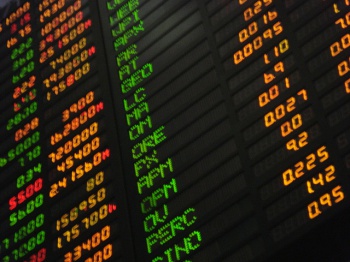 Stock Market Board by Katrina Tuliao
Stock Market Board by Katrina Tuliao
While most major world stocks posted losses on Monday, the price of gold marched to a record above $1,600 as investors worried about the European crisis and feared that US lawmakers could fail to raise the debt ceiling.
Canada’s Losses
Toronto’s main stock index (the S&P/TSX composite index) fell 71.44 points to 13,228.10 at 3:00 P.M. EDT. Most sectors were in red. The Royal Bank of Canada, Canada’s biggest lender by assets, decreased by 1.7 per cent, and Canada’s third largest lender by assets, The Bank of Nova Scotia, lost 1.9 per cent. Suncor Energy Inc., Canada’s biggest energy company, declined by 1.2 per cent. Canadian Natural Resources Ltd., the country‘s second-largest oil and gas producer, decreased 1 per cent to C$39.36, and the fifth-biggest energy company, Cenovus Energy Inc., fell 1.2 per cent. Moreover, the Canadian dollar lost 0.5 of a cent to land at 104.29 cents US. Industrial stocks also lost with Bombardier Inc., down 22 cents to $6.16, and Canadian National Railways fell by 75 cents.
“Concerns in the US and Europe are weighing on Canada, too. With commodity markets and oil down, there’s less confidence with the pace of recovery,” said Nathan Janzen, Royal Bank of Canada economist.
Gold and Silver are Soaring
 Gold Bullion by Bullion Vault
Gold Bullion by Bullion Vault
Gold stocks helped moderate losses as traders prefer to own gold over investments denominated in the dollar or the euro. Spot gold rose to $1,607.01 an ounce and was up 0.7 per cent at $1,603.89 an ounce by 2:20 P.M. EDT (1820 GMT). Goldcorp Inc., the world’s second-largest gold producer, increased by 2.3 per cent to C$52.79. Silver Wheaton Corp., Canada’s fourth-largest precious metals company, grew by 2.3 per cent to C$37.84, and Prophecy Platinum Corp. gained 21 per cent. According to economists, gold should rise above $1,700 an ounce in the next few months.
“A move to $2,000 in the next six to nine months is not that crazy in gold,” said Robert Lutts, chief investment officer of Cabot Money Management, which manages more than $500 million in assets.
Causes
The release of stress tests conducted on European banks was the main driver of the change. The European Banking Authority posted that only eight of the 90 EU banks it assessed had failed. But it doesn’t reflect the true status of European banking because it didn’t model what would happen if an EU country defaulted on its debt. Moreover, the yields on Italian and Spanish bonds rose again, and this means that investors are asking for higher premiums to lend them money, considering their markets as highly risky. At the same time, there are debt-ceiling talks in Washington, where lawmakers face an August 2nd deadline for raising the debt limit.
“Politicians on both sides of the Atlantic are not explaining realities to the voters, and this lack of leadership, as much as anything, remains a barrier to improvements in both market and economic prospects,” said David Kelly, chief market strategist at JP Morgan Funds. “The reality is that any solution to US debt problems will require a disciplined plan to both cut entitlement spending and raise taxes over a number of years. Any solution to the European debt problem will eventually require the richer nations in Europe to subsidize the budgets or at least the borrowing costs of their more troubled brethren.”

